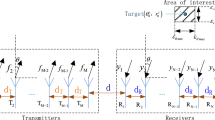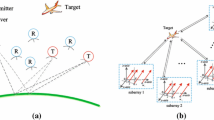Abstract
In this article, a novel technique is applied to achieve time-invariant spatial focusing performance for static and moving target by applying an irregular frequency modulation method to a frequency diverse array (FDA) waveform transmission system. The FDA radar can improve the anti-noise ability of the system by the means of concentrating the waveform energy on the required range or angle sector. However, the synthesized waveform has high sidelobes and is time-varying during the transmission waveform. In view of the above problems, a new waveform synthesis model of rang compensation frequency diverse array (TMRC-FDA) is established and the effect of parameter \(\varsigma\) on the waveform synthesis is analyzed. A new accelerated particle swarm optimization algorithm is used to optimize the distribution of parameter \(\varsigma\). The numerical simulation results show that the proposed TMRC-FDA waveform synthesis method achieves the goal of time invariance and reduces the waveform sidelobes. At the same time, it has better performance in terms of waveform focus compared to log-frequency offset FDA based on time-modulated and fixed parameters \(\varsigma\).











Similar content being viewed by others
References
Xu, J., Liao, G., & Zhu, S. (2014). Receive beamforming of frequency diverse array radar systems. In Proceedings of the General Assembly and Scientific Symposium(URSI GASS) (pp. 1–4).
Qin, S., Zhang, Y. D., Amin, M. G., & Gini, F. (2017). Frequency diverse coprime arrays with coprime frequency offsets for multitarget localization. IEEE Journal of Selected Topics in Signal Processing,11(2), 321–335.
Xu, J., Liao, G., Zhu, S., Huang, L., & So, H. C. (2015). Joint range and angle estimation using MIMO radar with frequency diverse array. IEEE Transactions on Signal Processing,63(13), 3396–3410.
Yao, A.-M., Wu, W., & Fang, D.-G. (2016). Frequency diverse array antenna using time-modulated optimized frequency offset to obtain time-invariant spatial fine focusing beampattern. IEEE Transactions on Antennas and Propagation,64(10), 4434–4446.
Wang, Z., Song, Y., Mu, T., & Ahmad, Z. (2018). A short-range range-angle dependent beampattern synthesis by frequency diverse array. IEEE Access,6, 22664–22669.
Antonik, P, Wicks, M. C., Griffiths, H. D., & Baker, C. J. (2006). Frequency diverse array radars. In Proceedings of 2006 IEEE conference on radar (pp. 215–217).
Wang, W. Q. (2014). Range-angle dependent transmit beampattern synthesis for linear frequency diverse arrays. IEEE Transactions on Antennas and Propagation,61(8), 4073–4081.
Xu, Y., Shi, X., Xu, J., & Li, P. (2015). Range-angle-dependent beamforming of pulsed frequency diverse array. IEEE Transactions on Antennas and Propagation,63(7), 3262–3267.
Khan, W., Qureshi, I. M., & Saeed, S. (2015). Frequency diverse array radar with logarithmically increasing frequency offset. IEEE Antenna Wireless Propagation Letters,14, 499–502.
Fartookzadeh, M., & Armaki, S. H. M. (2017). Synthesis of serial-fed frequency diverse arrays with periodic triangular frequency-modulated continous waveform. IEEE Antennas Wireless Propagation Letters,17(2), 263–266.
Yao, A.-M., Rocca, P., Wu, W., Massa, A., & Fang, D.-G. (2017). Synthesis of time-modulated frequency diverse arrays for short-range multi-focusing. IEEE Journal of Selected Topics in Signal Processing,11(2), 282–294.
Yao, A.-M., Rocca, P., Wu, W., & Massa, A. (2017). On the design of frequency diverse arrays for wireless power transmission. In Proceedings 11th European conference on antennas and propagation (pp. 900–903).
Khan, W., & Qureshi, I. M. (2014). Frequency diverse array radar with time-dependent frequency offset. IEEE Antennas Wireless Propagation Letters,13, 758–761.
Shao, H. Z., Dai, J., Xiong, J., Chen, H., & Wang, W.-Q. (2016). Dot-shaped range-angle beampattern synthesis for frequency diverse array. IEEE Antennas Wireless Propagation Letters,15, 1703–1706.
Wang, Y., Huang, G., & Li, W. (2017). Transmit beampattern design in range and angle domains for MIMO frequency diverse array radar. IEEE Antennas Wireless Propagation Letters,16, 1003–1006.
Quegan, S. (1997). Spotlight synthetic aperture radar: Signal processing algorithms. Journal of Atmospheric and Solar-Terrestrial Physics,5, 597–598.
Guo, R., Ni, Y., Liu, H., Wang, F., & He, L. (2017). Signal diverse array radar for electronic warfare. IEEE Antennas Wireless Propagation Letters,16, 2906–2910.
Guedria, N. B. (2016). Improved accelerated PSO algorithm for mechanical engineering optimization problems. Applied Soft Computing,40, 455–467.
Fang, D.-G., Yao, A.-M., & Wu, W. (2016). Synthesis of 4-D beampatterns using 4-D arrays. In Proceedings of the IEEE APS/URSI (pp. 703–704).
Balanis, C. A. (1997). Antenna theory analysis and design. New York: Wiley.
Yao, A.-M., Wu, W., & Fang, D. G. (2015). Single-sideband time-modulated phased array. IEEE Transactions on Antennas and Propagation,63(5), 1957–1968.
Yao, A.-M., Wu, W., & Fang, D.-G. (2015). Efficient and effective full-wave analysis of the instantaneous and average behaviors of time-modulated arrays. IEEE Transactions on Antennas and Propagation,63(7), 2902–2913.
Zhu, X., Yang, S., & Nie, Z. (2008). Full-wave simulation of time modulated linear antenna arrays in frequency domain. IEEE Transactions on Antennas and Propagation,56(5), 1479–1482.
Pozar, D. M. (2003). A relation between the active input impedance and the active element pattern of a phased array. IEEE Transactions on Antennas and Propagation,51(9), 2486–2489.
Pornsing, C., Sodhi, M. S., & Lamond, B. F. (2016). Novel self-adaptive particle swarm optimization methods. Soft Computing,20(9), 3579–3593.
Garg, H. (2016). A hybrid PSO-GA algorithm for constrained optimization problems. Applied Mathematics and Computation,274, 292–305.
Zavala, A. E. M., Aguirre, A. H., & Diharce, E. R. V. (2005). Particle evolutionary swarm optimization algorithm (PESO). In Proceedings of the Mexican international conference on computer science2005 (pp. 282–289).
Hasançebi, O., & Azad, S. (2012). An efficient metaheuristic algorithm for engineering optimization: SPOT. International Journal of Optimization in Civil Engineering,2, 479–487.
Author information
Authors and Affiliations
Corresponding author
Additional information
Publisher's Note
Springer Nature remains neutral with regard to jurisdictional claims in published maps and institutional affiliations.
Rights and permissions
About this article
Cite this article
Chu, W., Liu, YQ., Li, XL. et al. Optimization of Emission Waveform by Accelerated Particle Swarm Algorithm Based on Logarithmic Frequency Offset Mathematical Model. Wireless Pers Commun 113, 167–187 (2020). https://doi.org/10.1007/s11277-020-07184-7
Published:
Issue Date:
DOI: https://doi.org/10.1007/s11277-020-07184-7




